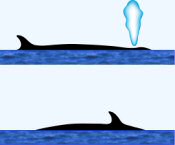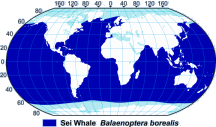Sei Whale
CLASS: Mammalia
ORDER: Cetacea
SUBORDER: Mysticeti
FAMILY: Balaenopteridae
GENUS: Balaenoptera
SPECIES: borealis
Sei (pronounced "say") and Bryde's (pronounced "broodus") whales are so similar that it was not until the early 1900's that the whalers realized they were hunting two different species. Sei whales acquired their name from the work seje, the Norwegian name for pollock, a close relative of codfish. Sei whales appeared off the coast of Norway at the same time each year as the pollock that came to feed on the abundant plankton. Bryde's whales are named after Johan Bryde, who initiated the South African whaling station where Bryde's whales were first described. Field identification between the two species is still difficult until one is close enough to see whether there are three ridges on top of the head (Bryde's whale) or just one (sei whale). To add to the confusion, some populations of Bryde's whales vary in size, color, and baleen structure in different geographical locations
Physical Description
Sei and Bryde's whales look very much alike, with only minor physical differences. Both species, like other rorquals (whales with a dorsal fin and long throat grooves on the lower side of their bodies) are slim and streamlined. The most noticeable difference between them is that the sei whale has a single ridge running from the tip of the snout to the blowholes, while the Bryde's whale has three ridges. The sei has 32 to 60 throat grooves, while the Bryde's has 40 to 50 throat grooves.

Surface Characteristics
Color
Sei whales have a bluish-gray body with white on the underside. Some of them have dark gray or almost white scars that may be caused by bites of lampreys (fish that attach themselves to the skin and bore into the flesh of some whales).
Fins and Fluke
The pectoral (side) fins are relatively short (only 9% to 10% of the body length) and pointed at the tips. The sei whale has a tall, falcate (curved) dorsal (top) fin. The dorsal fin is located about one-third of the body length forward of the notch in the fluke (tail). The flukes are also relatively small in relation to body size.
Length and Weight
The adult male sei whale measures 13.7 to 16.8 meters (45 to 55 feet), sometimes reaching a length of 19.8 meters (65 feet), and weights about 14 to 17 tons.
Feeding
Sei whales are baleen whales; they have a series of fringed, overlapping plates that hang from the upper jaw where teeth would be. The plates are composed of a fingernail-like material called keratin that frays out into fine hairs on the ends and inside the mouth next to the tongue. Sei whales have 320 to 380 baleen plates on each side, which are about 48 cm (19 inches) long. The plates are black outside, with a white fringe that is very fine and silky. Bryde's whales have 250 to 350 baleen plates on each side, which are about 42 cm (16 1/2 inches) long. Some of the baleen plates in the front of the mouth are white, while the rest of the plates are black. The fringe is stiff and coarse. The fine baleen of the sei whale adapts it for feeding on its favorite food, copepods (small crustaceans). There is some variation in their diet: they frequently eat fish in the North Pacific and krill (small, shrimp-like crustaceans) on occasion. The sei feeds on plankton (marine animal and plant organism that drift or float with currents and waves), which means it spends prolonged periods on the surface. Like right whales, they often open their mouths and skim the surface for their food. When doing this they blow or spout once every 1 to 2 minutes.
Mating and Breeding
Male sei whales reach sexual maturity at about 12.2 meters (40 feet), females at about 13.1 meters (50 feet), and at about the age of 10. The gestation period is 11 1/2 to 12 months, with calving taking place up to once every two years. Size at birth is 4.3 to 4.6 meters (14 to 15 feet). Weight at birth is about 2,000 pounds. Calves nurse for about 6 months in both species. Little else is known about the mating and breeding of these whales, although mating may occur year round.

Range Map
Distribution and Migration
Sei whales are usually found as solitary animals, or in small groups of 2 to 3. Once in a while a good food spot will be used by larger groups, and up to 100 sei whales have been seen in a limited area. The local distribution is probably related to the location of the whale's food source, and sei whales are well known for their sudden "invasions" of an area to exploit an available prey resource. Sei whales tend to inhabit more temperate waters than Bryde's whales, although neither species goes into the polar ice regions. Sei whales are found near the Antarctic, and go as far north as Iceland in the North Atlantic. Most rorquals are migratory, and sei whales show a seasonal movement pattern. Although their feeding grounds are well defined, no one knows where breeding takes place.
Natural History
Sei whales, swimming at speeds of up to 30 knots (34.5 miles per hour), are among the fastest baleen whales. When diving, they do not arch their back nor show their flukes, but simply sink below the surface. They often leave a series of tracks or "fluke prints", a smooth circle of water created by the movement of the fluke just below the surface of the water. Bryde's whales are more erratic and quicker on the surface, and make deeper dives. They arch their tail stock when diving, but do not show their flukes.
Status
Since they are slim and have little blubber, neither sei or Bryde's whales were hunted until the late 1950s. As fin and blue stocks were depleted by hunting, however, there was little the whalers could do but turn to sei whales and Bryde's whales. Between 1959 and 1971, 106,886 sei whales were killed in the Antarctic. Not surprisingly, a population crash followed which created the need to make them a protected species. Bryde's whales were next, and kills of Bryde's were highest in the early and mid-1970s. They, too, are now protected. Current population estimates for the sei whale are 54,000, or one-fifth of the original population; for the Bryde's 90,000 out of an original population of 100,000.
Bibliography
- Balcomb, Kenneth; Minasian, Stanley, The World's Whales. Illustrated by Larry Foster.
- A Complete Illustrated Guide. Smithsonian Books, New York: W. W. Norton, 1984.
- Ellis, Richard, The Book of Whales. New York: Alfred Knopf, 1980.
- Leatherwood, S.; Reeves, R., Whales and Dolphins. San Francisco: Sierra Club Books, 1983.
Acknowledgements
- We greatly appreciate the knowledge and assistance of Mason Weinrich of the Whale Center of New England, who contributed to the revision of this fact sheet.
- Illustrations courtesy Uko Gorter, copyright ©2017 all rights reserved.
FACT SHEETS MAY BE REPRINTED FOR EDUCATIONAL OR SCIENTIFIC PURPOSES
|



